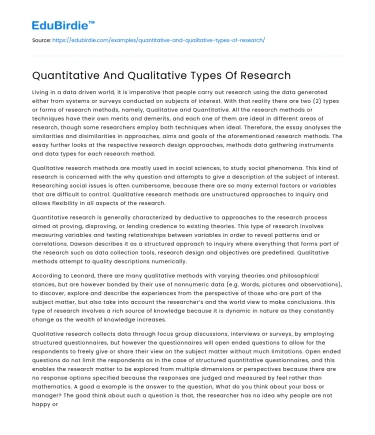Living in a data driven world, it is imperative that people carry out research using the data generated either from systems or surveys conducted on subjects of interest. With that reality there are two (2) types or forms of research methods, namely, Qualitative and Quantitative. All the research methods or techniques have their own merits and demerits, and each one of them are ideal in different areas of research, though some researchers employ both techniques when ideal. Therefore, the essay analyses the similarities and disimilarities in approaches, aims and goals of the aforementioned research methods. The essay further looks at the respective research design approaches, methods data gathering instruments and data types for each research method.
Qualitative research methods are mostly used in social sciences, to study social phenomena. This kind of research is concerned with the why question and attempts to give a description of the subject of interest. Researching social issues is often cumbersome, because there are so many external factors or variables that are difficult to control. Qualitative research methods are unstructured approaches to inquiry and allows flexibility in all aspects of the research.
Save your time!
We can take care of your essay
- Proper editing and formatting
- Free revision, title page, and bibliography
- Flexible prices and money-back guarantee
Quantitative research is generally characterized by deductive to approaches to the research process aimed at proving, disproving, or lending credence to existing theories. This type of research involves measuring variables and testing relationships between variables in order to reveal patterns and or correlations. Dawson describes it as a structured approach to inquiry where everything that forms part of the research such as data collection tools, research design and objectives are predefined. Qualitative methods attempt to quality descriptions numerically.
According to Leonard, there are many qualitative methods with varying theories and philosophical stances, but are however bonded by their use of nonnumeric data (e.g. Words, pictures and observations), to discover, explore and describe the experiences from the perspective of those who are part of the subject matter, but also take into account the researcher’s and the world view to make conclusions. this type of research involves a rich source of knowledge because it is dynamic in nature as they constantly change as the wealth of knowledge increases.
Qualitative research collects data through focus group discussions, interviews or surveys, by employing structured questionnaires, but however the questionnaires will open ended questions to allow for the respondents to freely give or share their view on the subject matter without much limitations. Open ended questions do not limit the respondents as in the case of structured quantitative questionnaires, and this enables the research matter to be explored from multiple dimensions or perspectives because there are no response options specified because the responses are judged and measured by feel rather than mathematics. A good a example is the answer to the question, What do you think about your boss or manager? The good think about such a question is that, the researcher has no idea why people are not happy or do like their managers, and it gives the respondents to freely give their reasons. These types of questions can be themed, e.g. what is your managers take on work life balance or is your boss a micro manager. The respondents might not have thought about the manager fostering work life balance and being micro managed.
Some qualitative questions can be vague, it would be much easier to ask a question such as, how often do you feel micro managed by your manager? with predefined responses such as, Always, Most of the time, Once in a while and so on. This type of questions are known as closed ended or quantitative questions. These type of questions are easier to respond to because the responses are already given and the responses can be converted to numbers.






 Stuck on your essay?
Stuck on your essay?

